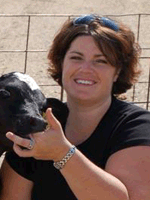
Guarding Calves Against Respiratory Disease – Ann Hoskins
 By Ann Hoskins, Vita Plus calf products coordinator
By Ann Hoskins, Vita Plus calf products coordinatorRespiratory disease is the second leading cause of mortality in calves under six months of age. In addition to death loss, respiratory disease negatively impacts other economic factors, including high treatment costs, reduced growth rate, delayed calving and increased culling.
Symptoms often include a temperature higher than 103.0 degrees, increased respiratory rates, reduced feed intake, coughing, nasal discharge and depression.
Common bacterial pathogens include Pasteurella multocida, Mannheimia (formerly Pasteurella) hemolytica, Haemophilus somnus and Mycoplasma. Viral pathogens include Parainfluenza, Infectious Bovine Rhinotracheitis (IBR), Bovine Viral Diarrhea Virus (BVDV) and, less commonly, Bovine Respiratory Syncytial Virus.
Vaccination can help control organisms that cause respiratory diseases. A quality vaccination program should be designed by the producer and veterinarian, tailored specifically to target local pathogens.
Early detection is essential to the success of any therapy. Identifying the causative agent is important. Most cases have some bacterial involvement and antibiotics can be of some value.
In order to have the best early detection program, develop a system to monitor the calf’s respiratory health. Key items to monitor include age, temperature, respiratory rate, ocular and nasal discharge, and fecal score. Note milk, starter and water intake as well as overall appearance of individual calves.
Environmental factors
Several environmental factors can predispose calves to respiratory infection. These include bedding type, poorly ventilated housing, drastic changes in temperature and nutritional stress.
A study conducted by the University of Wisconsin-Madison School of Veterinary Medicine found most calves in the Midwest do not have sufficient bedding to allow for nesting. Appropriate nesting is accomplished when a calf lies down and two-thirds of its legs have disappeared in the bedding. Long, clean straw makes the best bedding in cold temperatures.
It is very important to keep calves dry and free of fecal matter. This will reduce airborne bacteria at the calf level. Use the “knee test” to determine if the bedding is dry. Kneel in the bedding for 30 seconds; if your knee is dry upon standing, the bedding is dry.
Bedding should also be free of dust and mold. Avoid using shavings and sawdust with young calves and in maternity pens. These contain high amount of dust and small particles that are irritants to lungs and navels. Eliminate dust as much as possible when bedding pens or remove the cattle until the dust and small particles have settled.
Individual enclosed calf pens have been designed to prevent drafts, but they can inadvertently create highly polluted microenvironments of airborne bacteria associated with respiratory disease. Use solid panels between calves, but keep the front and back of individual stalls open. This can help to reduce bacterial pollution.
Whether using mechanical or natural ventilation, the goal is to provide fresh air uniformly at the calf level throughout the housing facility so all calves receive an adequate quantity of draft-free fresh air. A calf facility’s fresh air source is the ambient outside air. Therefore, proper ventilation means taking outside air and evenly distributing it throughout the barn.
A well-ventilated facility will allow for ample air flow and reduce drafts. When evaluating a facility, check ventilation and air quality at the calf level, approximately 12 to 14 inches above the bedding.
Reducing nutritional stress to the calf can limit or prevent susceptibility to the calf’s immune system. Underfeeding calves in cold temperatures will suppress the calf’s immune system because the calf won’t have enough energy to fight disease pressure. Providing fresh water along with high quality milk replacer and starter will deliver the nutrition needed to maintain good health.
Calf comfort plays an important role in raising healthy calves. Comfortable calves can use their nutrients for growth and are able to ward off the stresses of their environments more effectively.
Finally, don’t forget about your transition pens. Always move transition calves into a well-bedded and properly ventilated area. Provide adequate resting space and don’t overcrowd transition pens. Allowing adequate bunk space for all calves in transition pens will increase intakes and ensure struggling calves have the opportunity to eat. Don’t forget to clean waterers regularly.
It is best to avoid moving calves into an area with older animals, making rapid feed changes, vaccinating or causing stress on moving day. Make minimal changes and make those transitions slowly. Calf movement and introduction to other animals can be extremely stressful and should be done only when calves are at their healthiest.
Although cool and damp weather does increase respiratory issues in calves, remember that prevention and basic management strategies can reduce the incidence and severity of respiratory disease.
| Category: |
Animal health Bedding Sanitation Starting Strong - Calf Care |

